Top News
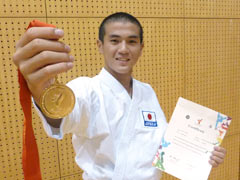
July 28, 2011 Ryukyu Shimpo
Third-year student 14 year-old Daigo Tamaki of Yabu Junior High School in Nago City was victorious at the 11th Asian Karate-do Championship held in Beijing, China from July 19.
The first person from Okinawa to compete in the Cadet category (14‐15 years of age) of the Championship, Tamaki participated in the kumite competition in the over 70-kilogram weight class.
He took part in three matches. In the first of these he beat an opponent from the Chinese team with a score of 5-2, before defeating an opponent from Indonesia 6-5 in the semi finals. In the final, Tamaki had a close match with a boy from Taiwan, edging through with a score of 3-0 in extra time.
Young Tamaki had a huge smile on his face, as he said “Although I felt nervous in facing a local opponent in the first match, I was still able to fight cautiously and calmly in both the semi-final and the final, even when I had the upper hand.”
Tsuguo Sakumoto, Chairman of the Technical Committee of the World Karate Federation, celebrated Tamaki’s victory, saying “We have had team members from Okinawa win the kata competition in the Championships in the past, but we have never really managed a satisfactory performance in the kumite competition. Tamaki did very well.”
Nago Mayor Susumu Inamine congratulated Tamaki, saying, “Tamaki’s victory will inspire not only children who practice karate, but also those who participate in other sports. The city is proud to be producing people who make an impact all over Asia and the world. Tamaki has provided us with dreams and hopes.”
(English Translation by T&CT, Mark Ealey)
Go To Japanese
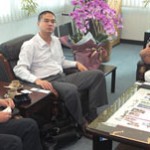
July 28, 2011 Ryukyu Shimpo
The Shanghai International Port Group (SIPG), China’s largest ports group, plans to send a cruise ship on tour with 1300 passengers between Shanghai and Naha, Ishigaki in October on a trial basis. If it receives a favorable reaction from Chinese tourists, the company will operate a regular cruise ship service on the same route, from around October 2012.
SIPG staff visited Okinawa on a pre-inspection visit from July 24 to July 28, meeting with Shigenobu Asato, Chairman of Okinawa Convention & Visitors Bureau (OCVB) to exchange courtesies.
Including trial visits, it will be the first tour to Okinawa by a cruise ship from Shanghai.
SIPG is China’s largest ports group, accounting for a quarter of the container traffic in mainland China. It also has cruise ships for its foreign routes and is involved in the shipbuilding industry. SIPG has chartered a cruise ship from China to Fukuoka, Nagasaki and Kagoshima Prefecture.
On the trial tour to Okinawa, it will use a cruise ship owned by another company. A cruise of approximately 53000 tons capable of carrying 1300 passengers will visit Ishigaki City, on October 14.
The company aims at wealthy passengers for their cruise ship business. Based on its cruise ship tour to Fukuoka prefecture in the past, it will bring an estimated economic benefit to Okinawa of more than 34 million yen.
SIPG staff visited the management association for Naha Port and at travel agencies to check on the local situation for inbound tourists.
Connie Zhang, the general manager for the company, said, “Okinawa is suited to being a resort because of its history, its scenery and the nature of its people. We have also been to the main islands of Japan, but from now on we will place our business focus on Okinawa.”
Chairman Asato said, “Okinawa has strong appeal for repeater tourists. We expect people from Shanghai will come back to Okinawa.”
(English Translation by T&CT, Mark Ealey)
Go To Japanese
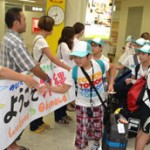
July 26, 2011 Ryukyu Shimpo
The volunteer group Tsunagu Hikari invited school children from Fukushima Prefecture to Okinawa as a part of a support project for victims of the Great East Japan Earthquake. Twenty elementary and junior high school students arrived at Naha Airport on the evening of July 25. They are scheduled to stay for one month until August 22 at Yuimarunomori House, which is located in Onna Village. During their stay, they will participate in a summer camp at Nakijin Village and enjoy eisa dancing.
Tsunagu Hikari has organized this project for children in the affected areas of Fukushima Prefecture who are unable to play outside because of radiation. The children will rest both their minds and bodies while in Okinawa. Kakuji Nakagawa, executive director of Tusnagu Hikari, said, “We hope that the exchange between the children of Fukushima and Okinawa will continue in future, and of course that they enjoy their one-month stay here in Okinawa.”
Suzu sato, a 10 year-old who participated with her 12 year-old brother Hyuga from Koriyama City, said, “I want to enjoy myself at the aquarium and on the beaches. I miss my mom a little bit when I see her picture.”
Tsunagu Hikari is looking for volunteers during the period of the project. Contact their Urasoe office phone: 098 (943) 3693.
(English Translation by T&CT, Mark Ealey)
Go To Japanese
July 27, 2011 Ryukyu Shimpo
On June 25, the first meeting in 2011 of the task force for the seashore rubbish problem (organized by the Okinawa Prefectural Government) was held at the Southern Joint Office of the OPG in Naha City. The members of organizations such as the national government, prefectural government, municipalities and volunteer groups attended the meeting in which they confirmed that they will work on the Okinawa Coastal Cleanup Operation at 33 beaches, including those of smaller outlying islands.
According to a survey on driftage that was reported on in the meeting, it is estimated that 976 tons of flotsam and jetsam washed up on the shores of all of the coastlines in the prefecture during the period from November 2010 to May 2011 (180 days), and in terms of volume, it is estimated that this equates to 11743 square meters. By region, the Miyako Islands end up as a repository for about half of the flotsam and jetsam for the entire area of Okinawa, both in terms of weight and volume.
The task force examined the amount of weight and volume of rubbish washed ashore at 23 beaches in the prefecture from November 2010 to May 2011 and extrapolated the overall situation of seashore rubbish in Okinawa prefecture from this survey with reference to figures from the survey of fiscal 2009.
By region, the Miyako Islands accounted for 460 tons, which is most of the weight. The small islands around the main island of the Okinawa followed at 215 tons, and main island of Okinawa with 184 tons. In terms of volume, Miyako Islands accounted for the most, at 6042 square meters, followed the main island with 2157 square meters, and the Yaeyama region with 1788 square meters.
By type of rubbish, there were large quantities found of plastic and wooden items and expanded polystyrene. By country of origin, estimated from the number of bottles washed ashore, China accounts for the majority of the seaborne rubbish.
(English Translation by T&CT, Mark Ealey)
Go To Japanese
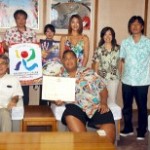
July 27, 2011 Ryukyu Shimpo
Okinawa Prefecture has accredited 47 year-old Hawaiian-born Japanese–Samoan former sumo wrestler Konishiki Yasokichi as the 219th cultural ambassador for Uchina (Okinawa). Certification as cultural ambassador for Uchina is granted to people who promote the charms of Okinawa overseas. Vice-governor Yoshiyuki Uehara handed the certificate to Konishiki at the Prefectural Government offices.
Before he retired, Konishiki reached ozeki, the second highest rank in professional sumo divisions.
His first visit to Okinawa was in 1982 as a tsukibito, an attendant of a higher ranked sumo wrestler, but he said that these days he comes to Okinawa several times a year.
Konishiki pointed out that Okinawa and Hawaii have many things in common such as kariyushi wear (the Okinawan version of Hawaiian shirts), and food culture, in which pork and potatoes are often used. He said, “There are many ingredients in Hawaii which are not used in Okinawa. I think it is a waste not to use them here. I hope Okinawa and Hawaii will collaborate on this.”
Uehara praised Konishiki, saying, “I would like Konishiki-san to keep passing on information about Okinawa.”
Konishiki indicated his support for the holding of a music festival between Okinawa and Hawaii and his desire to participate in the 5th Worldwide Uchinanchu Festival, which is scheduled to be held in October, saying, “I am really looking forward to taking part in the festival.”
Konishiki was born in Hawaii in 1963. After graduating from high school, he joined the Takasago stable and began his sumo career in 1982. He was promoted to the rank of ozeki before eventually retiring in 1997. Konishiki currently appears in Hawaiian music concerts and events as a celebrity.
(English Translation by T&CT, Mark Ealey)
Go To Japanese
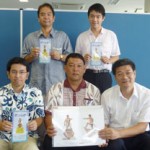
July 26, 2011 Ryukyu Shimpo
The association (Chairman Masajiro Nashiro) dedicated to the project is now working to erect a Ryukyu Uminchu (fishermen) statue at Keelung, Taiwan.
Since about 1905 Okinawan fishermen had a presence in Keelung, Taiwan, where they formed a community known as the “Ryukyu village.” They actively interacted with the locals and it is said that they taught local fishermen their methods of catching marlin. Elderly residents still remember their feelings of gratitude towards the Okinawan fishermen.
On July 22, Hsu Guang-hui, professor at Taiwan Police College and a representative of the founders of the association to erect the Uminchu statue, visited 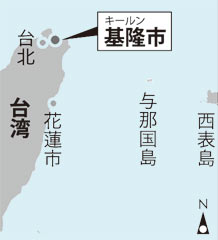 the Ryukyu Shimpo Office with his colleagues to introduce the association’s activities.
the Ryukyu Shimpo Office with his colleagues to introduce the association’s activities.
According to Hsu Guang-hui, many fishermen moved from Okinawa during Japan’s period of colonial rule over Taiwan following the Sino-Japanese War that ended in 1895, and it said that there were more than 500 Okinawan people living there in around 1921. As many as 3000 graves that have no one to tend them can be found in Wan Shan Gung and it is said that most of those people were from Okinawa.
One elderly gentleman said, “In those days, Okinawan fishermen helped Keelung to flourish. We had a good relationship.” Local residents still provide the incense and flowers at the temple for the long deceased fishermen.
Hsu Guang-hui said, “An ever-increasing number of people among the younger generation do not know anything about the history of Okinawan fishermen. Building this statue will contribute to building a base of friendship from which to convey this aspect of our history to the next generation.”
Daiya Miyazato, a member of the association board, and an extraordinary associate professor of Ryukyu University said, “We hope that the statue project will promote tourism for both sides.”
The association will continue to collect contributions towards the cost of construction of the statue until December. Construction is due to be completed this month, but donations have not yet reached the target figure of 5 million yen. Secretary of the association, Satoshi Ishihara, called for assistance saying, “We want many people to understand the spirit of our project – that we will complete this statue as a symbol of the friendship between Taiwan and Okinawa.”
Telephone inquiries should be directed to 098 (860) 5218.
(English Translation by T&CT, Mark Ealey)
Go To Japanese
July 25, 2011 Ryukyu Shimpo
The Marine Genomics Unit of the Okinawa Institute of Science and Technology (OIST, Onna Village) succeeded for the first time in deciphering the genome of Acropora digitifera, a coral that inhabits the seas around Okinawa Prefecture.
On July 24, the Unit published a collaborative paper in the online version of Nature, the world’s most cited interdisciplinary science journal, based in the United Kingdom.
Although previous analysis of fossil remains has suggested that this coral was estimated to have existed 240 million years ago, this new study indicates that there is a high possibility that it might actually have originated as long ago as 500 million years ago.
The Unit started three years ago. Thirty-three year-old Chuya Shinzato and other researchers from OIST joined it to work on deciphering the genome of this rare organism.
The study also revealed that the coral possesses the gene that creates a substance that can absorb ultraviolet rays in order to protect itself from the sun’s rays. Past studies presumed that the symbiotic zooxanthella inside the coral carried out this role.
The Unit will continue to study the genomic information of the zooxanthella and will focus on how the coral responds to rising sea temperatures and other environmental changes, in the hope that the studies will help to ascertain the cause of coral bleaching.
Dr. Noriyuki Sato, Principal Investigator of the Unit said, “Okinawa is a hot spot of the marine ecosystem. In future it could become a major center of coral studies with regard to genome deciphering.”
(English Translation by T&CT, Mark Ealey)
Go To Japanese

July 26, 2011 Ryukyu Shimpo
Okinawa Shogaku High School (Naha City) second year student Hitomi Uezu (17 years-old) has won the top prize in an art contest in Florida.
When in Florida as an exchange student at Jensen Beach High School on a scholarship program supported by the Okinawa Prefectural Government from August 2010 to June 2011, she painted about 20 works, and gained recognition from the local community. The local newspaper even ran an article about her achievements.
Uezu commented, “I now realize that art is universal and that its power transcends language barriers.”
She looked back on her experience in the United States and happily talked about its appeal.
Uezu has been painting since she was a small child, but the purpose of her study abroad was to learn English and further international exchange. Nevertheless, her love of beautiful things made her start painting.
Uezu said, “I thought everything was beautiful and artistic – the decorations of houses, the smells.”
She presented her works at several regional art contests, one of which received as many as 185000 entries in 30 categories such as “Poems” and “Novels.”
Uezu won the top prize in these contests, allowing her to enter the national competition.
One of her award-winning works, in fact her favorite, is called “Love Peggy,” a painting dedicated to her local host mother. Her host mother’s eyes glistened with emotion when she told to Peggy Hess the title of the painting.
Uezu said, “I am grateful to all those people in the United States who were so kind to me, and to the foundation and the school that gave me the opportunity to go to America.”
“I think it is important for me to focus not only on art but also on academics. I would like to study a range of subjects and add breadth to my art.”
(English Translation by T&CT, Mark Ealey)
Go To Japanese
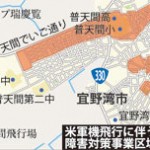
July 24, 2011 Ryukyu Shimpo
Residents living around the United States Marine Corps Air Station (USMCAS) Futenma in Ginowan City still have poor reception of terrestrial digital broadcasting due to flight activities. According to a survey that the Okinawa Defense Bureau conducted last year, it was confirmed that residents in about 900 buildings housing about 2000 households had poor reception of terrestrial digital broadcasts in an area including the three districts of Nodake, Futenma and Aragusuku, north of the airfield runway.
In June, the Ginowan City Office decided to provide cable television access to the households with poor reception within the areas indicated by the survey, with the cost covered in full by the Ministry of Defense. However, the City Office has also received complaints about reception of digital terrestrial TV from outside the stipulated area, so urgent measures are needed to deal with this. In these areas, viewers can generally watch TV normally but, they experience noise or the television screen goes black when an aircraft flies overhead.
The full payment for the installation of cable television services aims to eliminate interference to reception. Based on the Law Concerning the Improvement of Living Environment around Defense Facilities, the Ministry of Defense will pay the total cost for the cable installation work, a sum of about 98 million yen.
On July 4, the City Office set up an information desk service, giving counseling and accepting applications from residents in the affected areas. In the middle of this month it conducted briefings for residents and called on them to submit applications. By July 22, a total of 120 applications had been received. Meanwhile, in this month alone the City Office has received about 20 complaints from residents outside the area mentioned. The measures are still insufficient through the rest of the city. Masaru Shinzato, the head of the public relations section for the base of the City Office, stated for future action, “There are many complaints from residents living outside the stipulated area. We will ask the Defense Ministry to survey other areas and request that the Government cover the needs there too.”
Registrations will be accepted from residents of the stipulated area up to September 30 at the Ginowan City Office public relations section for the base. Telephone assistance is available on 098 (893) 4411 (extension: 310 & 312).
(English Translation by T&CT, Mark Ealey)
Go To Japanese
July 23, 2011 Ryukyu Shimpo
On July 22, Chairman of Ishigaki City Tourism Association Yasuhiro Miyahira held a press conference at which he announced that Club Med, which operates hotels and other businesses in the city, plans to have charter flights between Shanghai and Ishigaki. There will be about 20 flights from this December to next February.
It will be the first time to operate charter flights between these two locations. Club Med is going to transport tourists to its resorts in Ishigaki Island and, in conjunction with the airline, will carry out a field survey in Ishigaki Island in early August.
In response, the Ishigaki City Tourism Association will consider conducting a tourism promotion campaign in Shanghai in addition to the one already planned for Hong Kong.
After consulting with the Okinawa Prefectural Government and Okinawa Convention & Visitors Bureau, the City Tourism Association will carry out the promotion of Ishigaki tourism at an appropriate stage between this October and next February.
Staff of Club Med Shanghai along with representatives from airline and travel companies visited Ishigaki City Hall in 2009, at which time they indicated a willingness to send tourists to Ishigaki from Shanghai.
Chairman Miyahira said, “We want to create a road map for inviting tourists from China. Using this opportunity, we will launch a promotion campaign aimed at increasing numbers of inbound Chinese tourists.”
(English Translation by T&CT, Mark Ealey)
Go To Japanese
July 22, 2011 Ryukyu Shimpo
On July 21, the Jalan Research Center (JRC), which belongs to the travel division of RECRUIT CO., LTD. announced the results of the “Jalan Travel and Accommodation Survey 2011.”
Okinawa won two awards in seven categories of Japan’s best places to travel by prefecture: “Many appealing specialties and souvenirs” and “Warmth of hospitality of the local people.”
Okinawa has claimed the first place in these two categories for six consecutive years since JRC started these surveys in 2006 and has ranked within the top three in the other four categories.
JRC staff commented, “Okinawa is clearly very popular as a tourist destination.”
In addition to the regular categories, JRC surveyed travel trends for 2011 in the middle of April following the Great East Japan Earthquake. Comparing destinations to which people would like to travel to with those that they actually did travel to in 2010, JRC saw Okinawa come first among other prefectures and cities with regard to the ratio of the popularity to actual results.
The three prefectures in the Tohoku area of Aomori, Akita and Yamagata followed after Okinawa.
JRC staff explained this, saying, “In the context of a transition of mood in the Japanese people’s minds from voluntary restraint to rebuilding, people see Okinawa as relatively safe and as a comfortable place to stay. Those feelings played a crucial role in increasing the popularity of Okinawa as a tourist destination.”
With regard to the relatively high popularity of Tohoku areas, the staff of JRC said, “The survey results showed that the growing number of people considering travel to these areas would like to help in terms of the economic recovery of the region.”
JRC surveyed 15500 tourists nationwide.
In the category of “Many appealing specialties and souvenirs,” Okinawa earned popularity for local specialties such as Okinawa soba (a type of noodle soup eaten in Okinawa), sea grapes and the Okinawan purple sweet potato. Okinawa’s unique culture also helps to attract tourists.
In the category of “Warmth of hospitality of the local people,” tourists mentioned they were warmly welcomed in taxis, izakaya (Japanese-style pubs), and by the people in the streets and besides those in hotels and tourist spots.
Okinawa took second place in the categories of “Many attractive accommodation facilities,” “Many tourist attractions for kids” and “Many tourist attractions for young people.” It took third place in the category of “Many tourist attractions for adults.” In the category of “Provides many delicious foods unique to the locality,” Okinawa took fourth place.
The number of the tourists to Okinawa totaled 4610000 (tenth place in Japan) and the total amount of money spent on accommodation amounted to 429400 million yen (third in Japan). Both figures were down compared with the previous year.
(English Translation by T&CT, Mark Ealey)
Go To Japanese





 the Ryukyu Shimpo Office with his colleagues to introduce the association’s activities.
the Ryukyu Shimpo Office with his colleagues to introduce the association’s activities.

 Webcam(Kokusai Street)
Webcam(Kokusai Street)


